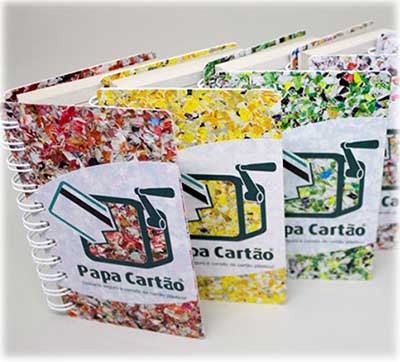
Transforming End-of-Life Payment Cards: Thales and Papa Cartão Pioneer Recycling and Second-Life Solutions
Discover this customer case from Papa Cartao and learn how expired payment cards are not only recycled but also benefit from recycling to gain a second life.
There's a bunch of frequently asked questions on Google about credit cards end-of-life, such as: "What to do with old credit cards" or "How to dispose of old credit cards" or even "How to destroy credit cards."
Usually, these questions come to your mind whether your payment card has expired or if you want to renew your card before the expiration date.
As an eco-conscious consumer, you may also look for some guidance in doing the right thing.
We'll answer these questions precisely.
We'll also unveil a recycling process we've successfully implemented for some of our clients.
But let's first understand what credit cards are made of.
What are credit cards made of?
A banking card is usually composed of the following raw materials:
- Several layers of laminated plastic, usually using PVC, alternatively PET or a bio-sourced material.
- Inks for printing credit cards with a magnetic stripe. Metal oxide particles with solvents are often the basis for inks.

There are different types of cards, all using different materials (plastic, plastic substitute, metal, and chips…).
As a consequence, the way we should dispose of them should be adapted to each component. We can easily imagine the metal within the card shall go to a different recycling stream than the plastics.
Do financial institutions give any recommended process?
There is no international regulation to impose how we should manage cards when they expire or are replaced.
The truth is that there is no clear indication either, as it may depend on local regulations.
The result?
Most of the time, consumers throw them away in a bin after cutting the card into pieces.
Needless to say, there's still room for improvement for these 6 billion payment cards in circulation in 2020.
Because the card will come back to us.
Why is that?

The toxic journey of a credit card
What happens to the banking cards after we throw them into the trash bin?
Every year we use 30 million kg PVC for banking card issuance, the equivalence of the weight of about 150 Boeing 747s.
In most cases, banking cards will either go to the landfill or be thrown into nature. This is the worst-case scenario as it will gradually turn into microplastic and gets back to us.
You read that well.
It will get back to us because we will ingest the particles through the food chain. It's already happening now. In fact, according to a study by the World Wildlife Fund, you are probably swallowing microplastic equal to the weight of a credit card each week!
That's where recycling fits in.
What benefits does recycling bring?
According to Wikipedia, recycling means converting waste materials into new materials and objects.
When we talk about materials, we mean paper, glass, cardboard, metal, plastic, tires, textiles, batteries, and electronics.
The main benefits of recycling are to bring service to the community and the environment.
The underlying idea is to fight for a healthier and better planet. Global warming and other related environmental topics, such as deforestation, and polluting with hazardous materials, need to be considered.
There is also a different way to dispose of waste: reducing greenhouse gas emissions.
Recycling has many advantages as it significantly decreases the amount of waste that would typically end up in landfills (reducing water pollution) and incinerators (reducing air pollution).
- It also enables the preservation of natural resources of material by allowing the production of new products with second-hand materials instead of virgin ones. It prevents pollution during extraction as there are fewer new raw materials to collect. Furthermore, at end of life, the volume of waste sent to landfill is limited.
- It saves energy.
- It creates jobs in the recycling and manufacturing industries.
When we speak of recycling, we usually refer to the 3 R's Reduce, reuse, and recycle as a waste hierarchy used as guidance for creating a sustainable life.

The principle of the 3Rs is:
- The first "R" Reduce, means less production as there will be less to recycle or reuse. This can be applied to a material or a process. This can also mean buying products with less packaging or limiting the waste of your production.
- The second "R" Reuse stands for the action of using something again.
- The third "R" Recycle means transforming something into a new raw material used to create a new item for a 2nd life.
In essence, these 3Rs translate into a lighter manufacturing footprint, fewer virgin materials to buy and process, and less waste ending up in landfill.
Can plastic credit payment cards be recycled?
The answer is YES, but it's not that obvious.
Every banking card is a well-designed compound made up of metals (copper, nickel, gold, aluminum, iron), resin, glass, silicon, and plastics (PVC, PET).
This complexity makes recycling payment cards challenging.
Here comes the good news.
As part of many other eco-friendly initiatives, Thales DIS decided to have a closer look at reducing and neutralizing the footprint of a banking card, including a responsible and trustworthy service to dispose of it correctly.
What is the process?
How does the recycling process work?
It's all about being responsible and trustworthy.
The bank will be the one in charge of collecting the cards from their customers, and Thales DIS acts as an aggregator to shred and store everything in the secured facility. It will then be sent to a recycling facility once it reaches a specific volume. The process will occur either in the country or, if feasible, in a neighbouring country.
This is what happens in the recycling facility:
Recover plastic and metal:
- The cards contain plastic (like PVC, PLA, PET): during the separation of materials, plastic and metal are isolated... Recycling metals and plastic and selling them to the second-hand market allows for the recovery of essential resources, which can then be reused in the industry.
- As an alternative, all can be incinerated to recover the energy, meaning the recovered heat can be injected to an industrial installation or to an institution.
- In incineration process, Bio-sourced material such as PLA (Poly Lactic Acid) is a better option than PVC, as it will not generate toxic gas during incineration.
Recycle metals:
- The metal will be sent to manufacturing for a second life: depending on the metal recycling processor, metal will be valued and re-injected into the metal industry.
Thales' recycling solution benefits
Thales DIS's mission in recycling cards is fully aligned with its Corporate Social Responsibility chart.
The process prevents card material from being dropped off to any landfill as we collect and recover the plastic. Thales further ensures eco-responsibility by selecting recycling partners with a multi-country footprint. This strategic choice allows the creation of local recycling offers and facilitates the delivery of collection and recycling solutions to banks.
To sum up:
- 0% landfill: the entire process recycles plastic and metal which results in minimum waste going to landfills.
- Eco-friendly process: the process is 100% conducted in the country or a neighbour country to minimise the carbon footprint linked to transportation.
- Proven experience: our partners have already processed and recycled tons of waste from Thales or other plastic and metal industries.
More resources on our carbon offset program and eco-friendly cards
If you read this dossier through, this means that you're concerned about the environmental impact of cards as much as your customers are, and we are.
That's why we offer a full set of tools that enables our clients to build a consistent, environmentally sustainable strategy.
Thales focuses on collaboration and eco-innovation. More precisely, we support banks in every aspect of a bank card's life, from eco-friendly credit card material selection to carbon-offset programs.
- Eco-friendly substitute to plastic credit cards – The bio-sourced alternative.
- Carbon neutrality: Everything you need to know to offset the carbon footprints of your cards
- Revisiting eco-friendly credit cards – Doconomy at the forefront of changes reshaping the card industry
- Eco-friendly bank card's life cycle: supporting your environmental-friendly practices
- Visit our Thales blog: https://dis-blog.thalesgroup.com/financial-services/
We'll be delighted discuss your collection and recycling projects with you. Don't hesitate to contact us.
Where do we fit in?
You can discover more about our response to climate change in Thales' CSR report.
In a nutshell, Thales DIS is committed to Corporate Social Responsibility:
- In 2009, we launched carbon footprint programs to reduce gas emissions from our operations and freight.
- We have a carbon offset program to support our customers in reaching carbon neutrality (25,000 tons of CO2eq so far)
- We also propose a range of eco-friendly products with bio-sourced payment cards made from PLA (corn-derived polymer replacing petroleum-based plastic) and reclaimed cards using plastic from the oceans. Thales invests continuously to offer sustainable card materials alternatives to PVC for newly issued cards. Contact your sales representative to know more
Transforming End-of-Life Payment Cards: Thales and Papa Cartão Pioneer Recycling and Second-Life Solutions

Thales’ existing and new customers can leverage this unique service to manage the card end-of-life process more responsibly. The process begins with the collection and manual shredding of cards at designated collection points, requiring no electrical power. The shredded waste is then transported to recycling locations, where it is transformed into second-life objects such as cup holders, pencil holders and notebooks, in line with the customers’ choice.
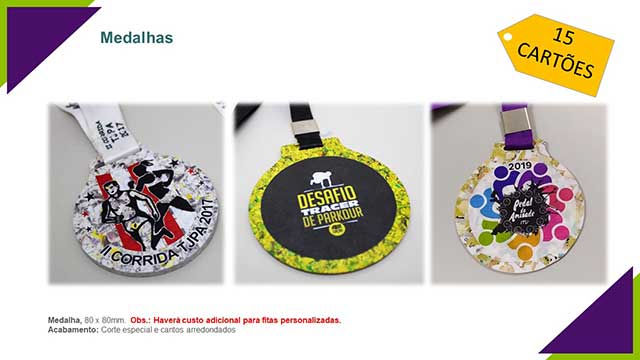
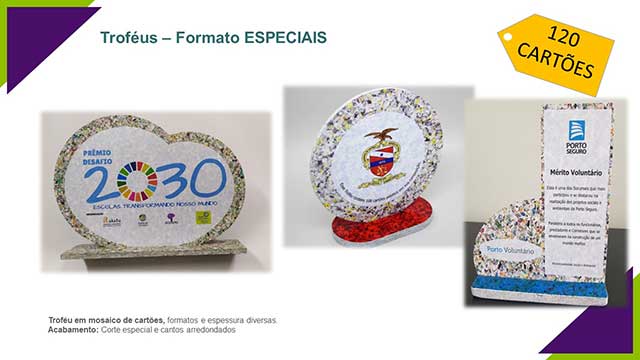
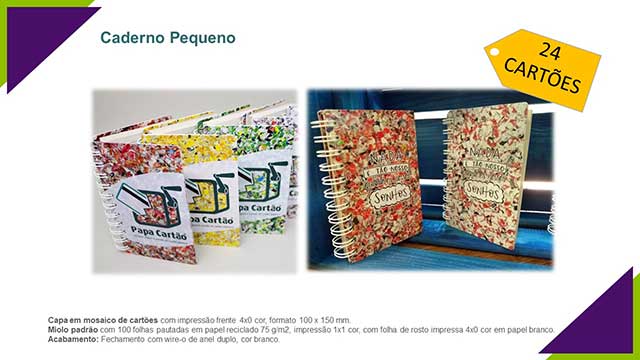
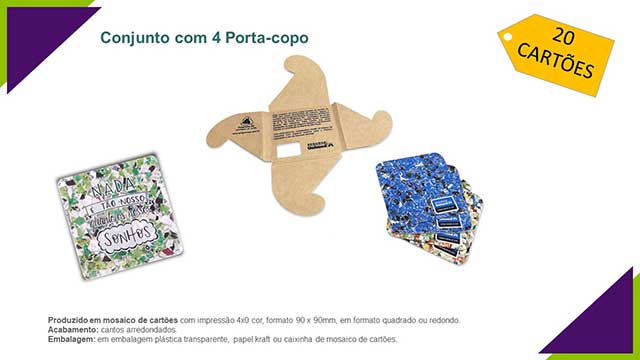
This innovative approach not only reduces the environmental impact of cards but also allows banks and meal voucher providers to showcase their commitment to sustainability. By offering a range of customisable second-life products, Papa Cartão empowers clients to enhance customer engagement through eco-friendly initiatives, giving them control over the circularity of their resources by selecting their preferred recycled objects.
Established in partnership with Thales, by the middle of 2024 this recycling service had already collected more than 65,000 cards from seven clients in the country, showcasing a scalable and impactful solution for the industry.
Through this collaboration, Thales and Papa Cartão are setting new standards in eco-friendly practices, fostering greater customer loyalty and enhancing brand reputations in a rapidly evolving market.